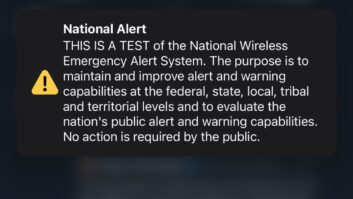Here’s a story of interest to those who follow emergency alerting in the United States:
The FCC has now published the list of questions that it asked major wireless companies about the recent national test of the Wireless Emergency Alert system.
Answers from the companies to the questions were already available on the FCC website, but those answers make more sense now that the original questions are also publicly available.
The national WEA test was held in August concurrently with the national EAS test that involved broadcasters. The test would have been seen only by mobile users who had opted in on their devices.
The commission had sent letters to Verizon, T-Mobile and AT&T ahead of time asking them to file voluntary comments about the performance of the test on their networks. (Read the letter.)
Among the questions it asked each to answer were: Did the carrier receive the nationwide test message and transmit it to its subscribers in all geographic areas where it offers WEA coverage? At what time, to the closest millisecond, did its gateway receive the alert from FEMA IPAWS, and when did it transmit the alert to subscribers? Were there complications with alert processing or transmission? What differences were noted in WEA performance between 3G, 4G and 5G networks?
The carriers’ responses are public; the links below will open or download their filed replies:
AT&T is confident the alert was transmitted to all geographic areas. The company said alert transmission to subscribers started 40 seconds after it received it from IPAWS. AT&T had employees in 37 cities enabling the test alert on a variety of Android and iOS devices and found a 99% completion rate, though apparently the test alert was received twice by some users. “We believe we understand the reason and are working with the vendor to confirm the cause of this duplication,” it wrote.
Verizon cited a 55-second turnaround time. It said it saw several cell sites restart at various times during the alert, so those sites were late to broadcast the alert, but it said customer impact would be minimal due to coverage redundancy. “The device would ignore the later alert broadcast of the restarted cell site as a duplicated alert because the devices had already received the same alert earlier from other available cell sites.” It also noted that it received anecdotal reports that some consumer handsets didn’t receive the alert, but said some users may have misunderstood how to opt into the relatively new State/Local alert category on their devices.
And T-Mobile said it had more 50 devices monitoring the test and that it had experienced no issues, even though real WEA alerts were issued in some parts of the country during the test. (T-Mobile had redacted some of the information in the public version of its letter, citing security reasons, but subsequently released it without the redactions.)












